E-Commerce Law: Legal Analysis of Trademark Infringement and Remedies
VerifiedAdded on 2021/06/14
|6
|1331
|228
Report
AI Summary
This report provides a comprehensive analysis of trademark infringement within the context of e-commerce law, focusing on a scenario where a company, Sofia's, is accused of infringing on Google's trademarks. The report begins by introducing the legal framework, including the Trade Marks Act 194 of 1993, and defines trademark infringement, referencing relevant sections of the Act. It then outlines available remedies for trademark owners, such as injunctions, removal of infringing marks, and claims for damages and royalties. The report presents a case study involving Sofia's company, which used images and slogans that were registered trademarks of Google. The analysis considers the defenses available to Sofia, including good faith usage and descriptive use. The report references the Beecham Group plc v Triomed (Pty) Ltd case to highlight the distinctiveness benchmark for shape marks. The conclusion summarizes the legal arguments Sofia can use to defend against Google's claims, including the remedies available and the application of the Trade Marks Act. The report also mentions that unregistered marks are protected by common law, and that there is no statute of limitations for filing trademark infringement actions. The report is supported by references to relevant legal cases and academic articles.
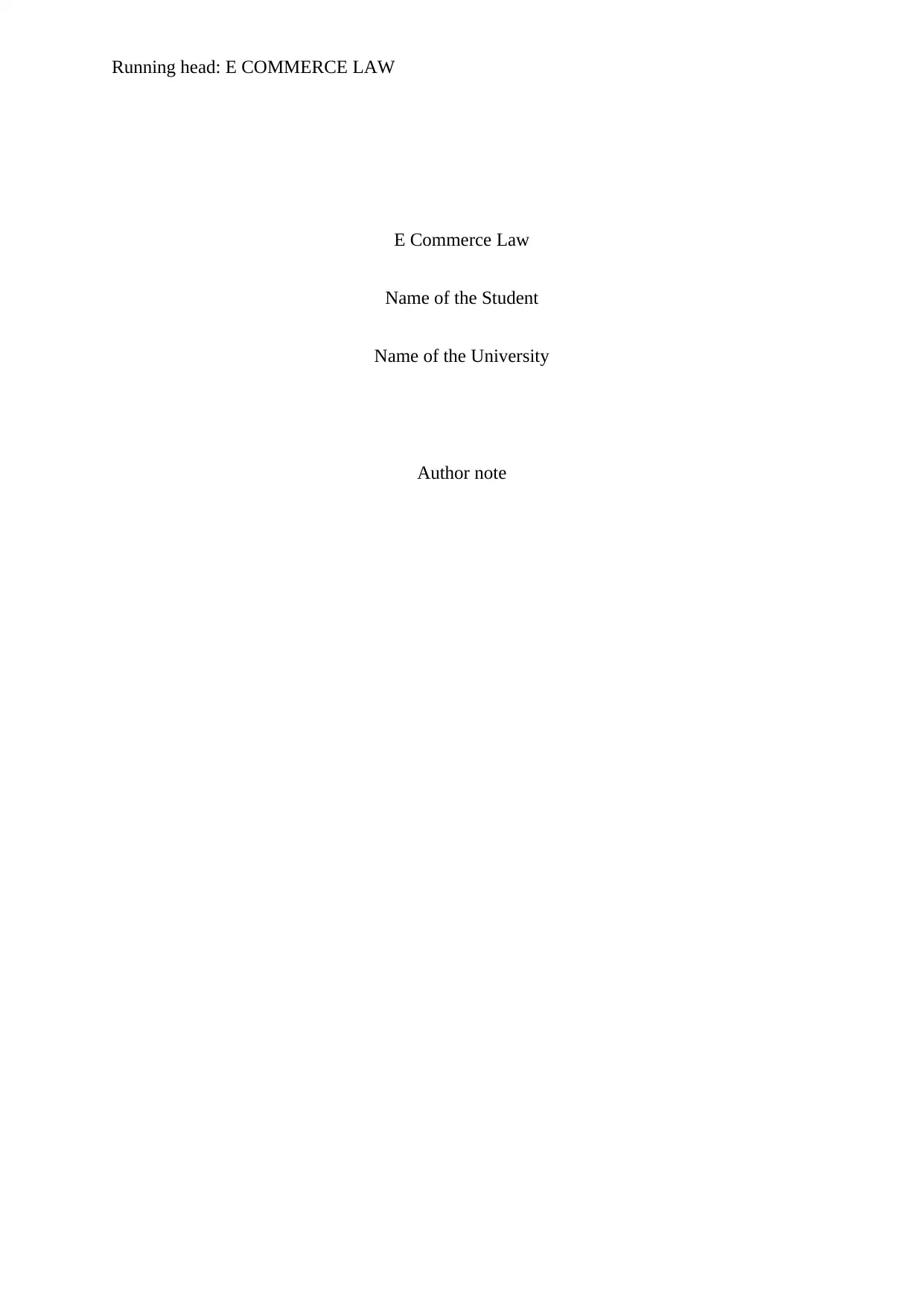
Running head: E COMMERCE LAW
E Commerce Law
Name of the Student
Name of the University
Author note
E Commerce Law
Name of the Student
Name of the University
Author note
Paraphrase This Document
Need a fresh take? Get an instant paraphrase of this document with our AI Paraphraser
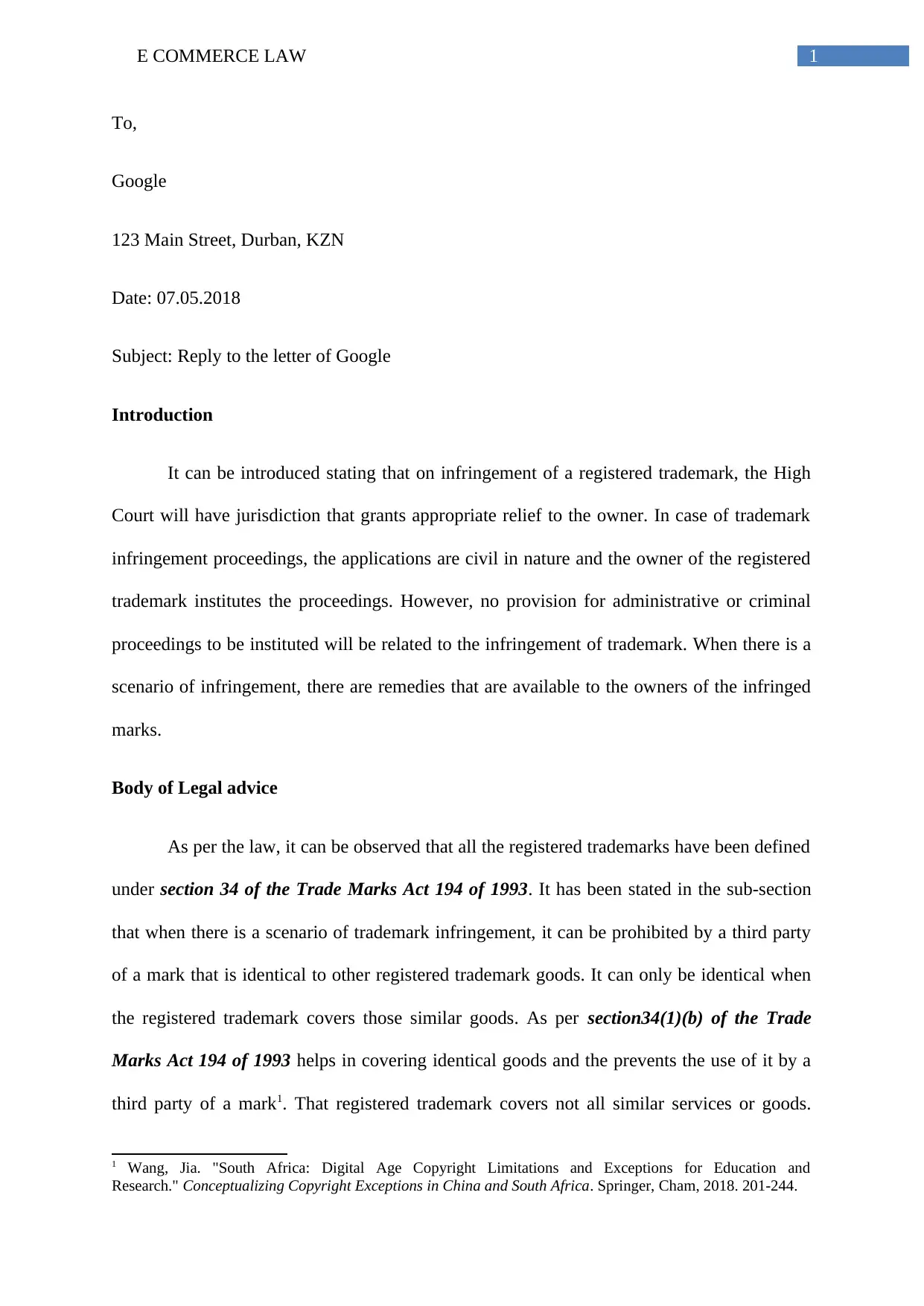
1E COMMERCE LAW
To,
Google
123 Main Street, Durban, KZN
Date: 07.05.2018
Subject: Reply to the letter of Google
Introduction
It can be introduced stating that on infringement of a registered trademark, the High
Court will have jurisdiction that grants appropriate relief to the owner. In case of trademark
infringement proceedings, the applications are civil in nature and the owner of the registered
trademark institutes the proceedings. However, no provision for administrative or criminal
proceedings to be instituted will be related to the infringement of trademark. When there is a
scenario of infringement, there are remedies that are available to the owners of the infringed
marks.
Body of Legal advice
As per the law, it can be observed that all the registered trademarks have been defined
under section 34 of the Trade Marks Act 194 of 1993. It has been stated in the sub-section
that when there is a scenario of trademark infringement, it can be prohibited by a third party
of a mark that is identical to other registered trademark goods. It can only be identical when
the registered trademark covers those similar goods. As per section34(1)(b) of the Trade
Marks Act 194 of 1993 helps in covering identical goods and the prevents the use of it by a
third party of a mark1. That registered trademark covers not all similar services or goods.
1 Wang, Jia. "South Africa: Digital Age Copyright Limitations and Exceptions for Education and
Research." Conceptualizing Copyright Exceptions in China and South Africa. Springer, Cham, 2018. 201-244.
To,
123 Main Street, Durban, KZN
Date: 07.05.2018
Subject: Reply to the letter of Google
Introduction
It can be introduced stating that on infringement of a registered trademark, the High
Court will have jurisdiction that grants appropriate relief to the owner. In case of trademark
infringement proceedings, the applications are civil in nature and the owner of the registered
trademark institutes the proceedings. However, no provision for administrative or criminal
proceedings to be instituted will be related to the infringement of trademark. When there is a
scenario of infringement, there are remedies that are available to the owners of the infringed
marks.
Body of Legal advice
As per the law, it can be observed that all the registered trademarks have been defined
under section 34 of the Trade Marks Act 194 of 1993. It has been stated in the sub-section
that when there is a scenario of trademark infringement, it can be prohibited by a third party
of a mark that is identical to other registered trademark goods. It can only be identical when
the registered trademark covers those similar goods. As per section34(1)(b) of the Trade
Marks Act 194 of 1993 helps in covering identical goods and the prevents the use of it by a
third party of a mark1. That registered trademark covers not all similar services or goods.
1 Wang, Jia. "South Africa: Digital Age Copyright Limitations and Exceptions for Education and
Research." Conceptualizing Copyright Exceptions in China and South Africa. Springer, Cham, 2018. 201-244.
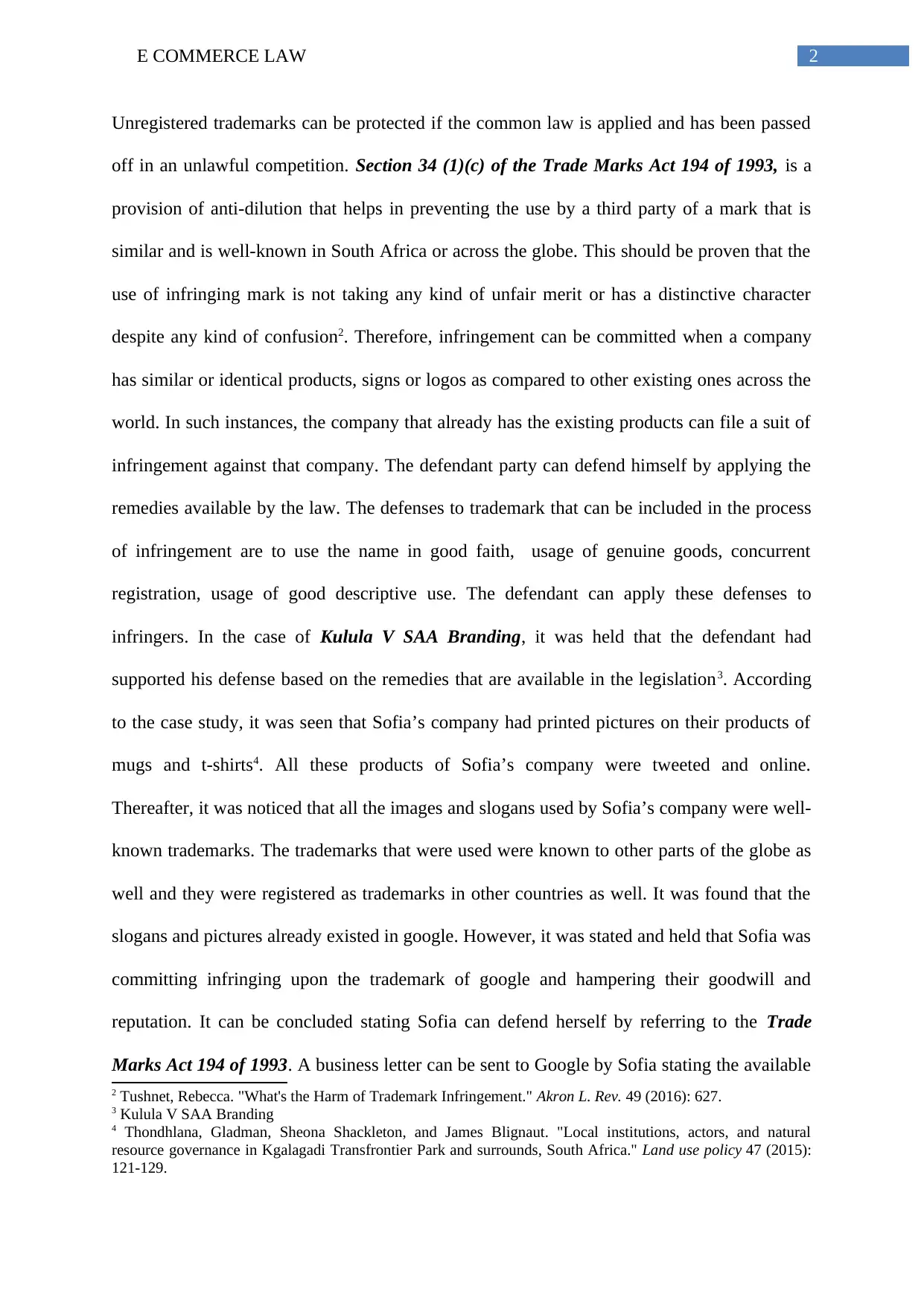
2E COMMERCE LAW
Unregistered trademarks can be protected if the common law is applied and has been passed
off in an unlawful competition. Section 34 (1)(c) of the Trade Marks Act 194 of 1993, is a
provision of anti-dilution that helps in preventing the use by a third party of a mark that is
similar and is well-known in South Africa or across the globe. This should be proven that the
use of infringing mark is not taking any kind of unfair merit or has a distinctive character
despite any kind of confusion2. Therefore, infringement can be committed when a company
has similar or identical products, signs or logos as compared to other existing ones across the
world. In such instances, the company that already has the existing products can file a suit of
infringement against that company. The defendant party can defend himself by applying the
remedies available by the law. The defenses to trademark that can be included in the process
of infringement are to use the name in good faith, usage of genuine goods, concurrent
registration, usage of good descriptive use. The defendant can apply these defenses to
infringers. In the case of Kulula V SAA Branding, it was held that the defendant had
supported his defense based on the remedies that are available in the legislation3. According
to the case study, it was seen that Sofia’s company had printed pictures on their products of
mugs and t-shirts4. All these products of Sofia’s company were tweeted and online.
Thereafter, it was noticed that all the images and slogans used by Sofia’s company were well-
known trademarks. The trademarks that were used were known to other parts of the globe as
well and they were registered as trademarks in other countries as well. It was found that the
slogans and pictures already existed in google. However, it was stated and held that Sofia was
committing infringing upon the trademark of google and hampering their goodwill and
reputation. It can be concluded stating Sofia can defend herself by referring to the Trade
Marks Act 194 of 1993. A business letter can be sent to Google by Sofia stating the available
2 Tushnet, Rebecca. "What's the Harm of Trademark Infringement." Akron L. Rev. 49 (2016): 627.
3 Kulula V SAA Branding
4 Thondhlana, Gladman, Sheona Shackleton, and James Blignaut. "Local institutions, actors, and natural
resource governance in Kgalagadi Transfrontier Park and surrounds, South Africa." Land use policy 47 (2015):
121-129.
Unregistered trademarks can be protected if the common law is applied and has been passed
off in an unlawful competition. Section 34 (1)(c) of the Trade Marks Act 194 of 1993, is a
provision of anti-dilution that helps in preventing the use by a third party of a mark that is
similar and is well-known in South Africa or across the globe. This should be proven that the
use of infringing mark is not taking any kind of unfair merit or has a distinctive character
despite any kind of confusion2. Therefore, infringement can be committed when a company
has similar or identical products, signs or logos as compared to other existing ones across the
world. In such instances, the company that already has the existing products can file a suit of
infringement against that company. The defendant party can defend himself by applying the
remedies available by the law. The defenses to trademark that can be included in the process
of infringement are to use the name in good faith, usage of genuine goods, concurrent
registration, usage of good descriptive use. The defendant can apply these defenses to
infringers. In the case of Kulula V SAA Branding, it was held that the defendant had
supported his defense based on the remedies that are available in the legislation3. According
to the case study, it was seen that Sofia’s company had printed pictures on their products of
mugs and t-shirts4. All these products of Sofia’s company were tweeted and online.
Thereafter, it was noticed that all the images and slogans used by Sofia’s company were well-
known trademarks. The trademarks that were used were known to other parts of the globe as
well and they were registered as trademarks in other countries as well. It was found that the
slogans and pictures already existed in google. However, it was stated and held that Sofia was
committing infringing upon the trademark of google and hampering their goodwill and
reputation. It can be concluded stating Sofia can defend herself by referring to the Trade
Marks Act 194 of 1993. A business letter can be sent to Google by Sofia stating the available
2 Tushnet, Rebecca. "What's the Harm of Trademark Infringement." Akron L. Rev. 49 (2016): 627.
3 Kulula V SAA Branding
4 Thondhlana, Gladman, Sheona Shackleton, and James Blignaut. "Local institutions, actors, and natural
resource governance in Kgalagadi Transfrontier Park and surrounds, South Africa." Land use policy 47 (2015):
121-129.
⊘ This is a preview!⊘
Do you want full access?
Subscribe today to unlock all pages.

Trusted by 1+ million students worldwide
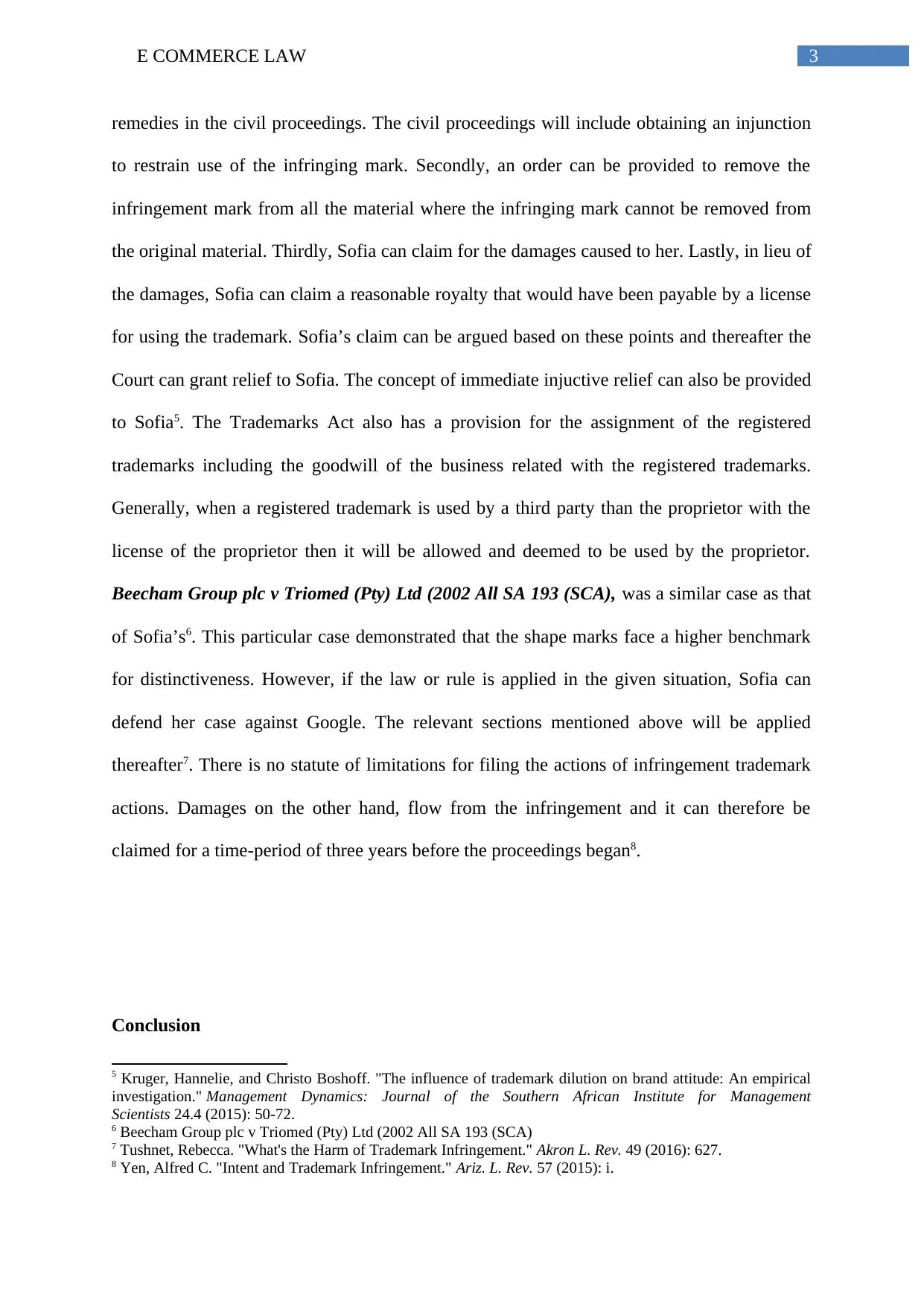
3E COMMERCE LAW
remedies in the civil proceedings. The civil proceedings will include obtaining an injunction
to restrain use of the infringing mark. Secondly, an order can be provided to remove the
infringement mark from all the material where the infringing mark cannot be removed from
the original material. Thirdly, Sofia can claim for the damages caused to her. Lastly, in lieu of
the damages, Sofia can claim a reasonable royalty that would have been payable by a license
for using the trademark. Sofia’s claim can be argued based on these points and thereafter the
Court can grant relief to Sofia. The concept of immediate injuctive relief can also be provided
to Sofia5. The Trademarks Act also has a provision for the assignment of the registered
trademarks including the goodwill of the business related with the registered trademarks.
Generally, when a registered trademark is used by a third party than the proprietor with the
license of the proprietor then it will be allowed and deemed to be used by the proprietor.
Beecham Group plc v Triomed (Pty) Ltd (2002 All SA 193 (SCA), was a similar case as that
of Sofia’s6. This particular case demonstrated that the shape marks face a higher benchmark
for distinctiveness. However, if the law or rule is applied in the given situation, Sofia can
defend her case against Google. The relevant sections mentioned above will be applied
thereafter7. There is no statute of limitations for filing the actions of infringement trademark
actions. Damages on the other hand, flow from the infringement and it can therefore be
claimed for a time-period of three years before the proceedings began8.
Conclusion
5 Kruger, Hannelie, and Christo Boshoff. "The influence of trademark dilution on brand attitude: An empirical
investigation." Management Dynamics: Journal of the Southern African Institute for Management
Scientists 24.4 (2015): 50-72.
6 Beecham Group plc v Triomed (Pty) Ltd (2002 All SA 193 (SCA)
7 Tushnet, Rebecca. "What's the Harm of Trademark Infringement." Akron L. Rev. 49 (2016): 627.
8 Yen, Alfred C. "Intent and Trademark Infringement." Ariz. L. Rev. 57 (2015): i.
remedies in the civil proceedings. The civil proceedings will include obtaining an injunction
to restrain use of the infringing mark. Secondly, an order can be provided to remove the
infringement mark from all the material where the infringing mark cannot be removed from
the original material. Thirdly, Sofia can claim for the damages caused to her. Lastly, in lieu of
the damages, Sofia can claim a reasonable royalty that would have been payable by a license
for using the trademark. Sofia’s claim can be argued based on these points and thereafter the
Court can grant relief to Sofia. The concept of immediate injuctive relief can also be provided
to Sofia5. The Trademarks Act also has a provision for the assignment of the registered
trademarks including the goodwill of the business related with the registered trademarks.
Generally, when a registered trademark is used by a third party than the proprietor with the
license of the proprietor then it will be allowed and deemed to be used by the proprietor.
Beecham Group plc v Triomed (Pty) Ltd (2002 All SA 193 (SCA), was a similar case as that
of Sofia’s6. This particular case demonstrated that the shape marks face a higher benchmark
for distinctiveness. However, if the law or rule is applied in the given situation, Sofia can
defend her case against Google. The relevant sections mentioned above will be applied
thereafter7. There is no statute of limitations for filing the actions of infringement trademark
actions. Damages on the other hand, flow from the infringement and it can therefore be
claimed for a time-period of three years before the proceedings began8.
Conclusion
5 Kruger, Hannelie, and Christo Boshoff. "The influence of trademark dilution on brand attitude: An empirical
investigation." Management Dynamics: Journal of the Southern African Institute for Management
Scientists 24.4 (2015): 50-72.
6 Beecham Group plc v Triomed (Pty) Ltd (2002 All SA 193 (SCA)
7 Tushnet, Rebecca. "What's the Harm of Trademark Infringement." Akron L. Rev. 49 (2016): 627.
8 Yen, Alfred C. "Intent and Trademark Infringement." Ariz. L. Rev. 57 (2015): i.
Paraphrase This Document
Need a fresh take? Get an instant paraphrase of this document with our AI Paraphraser
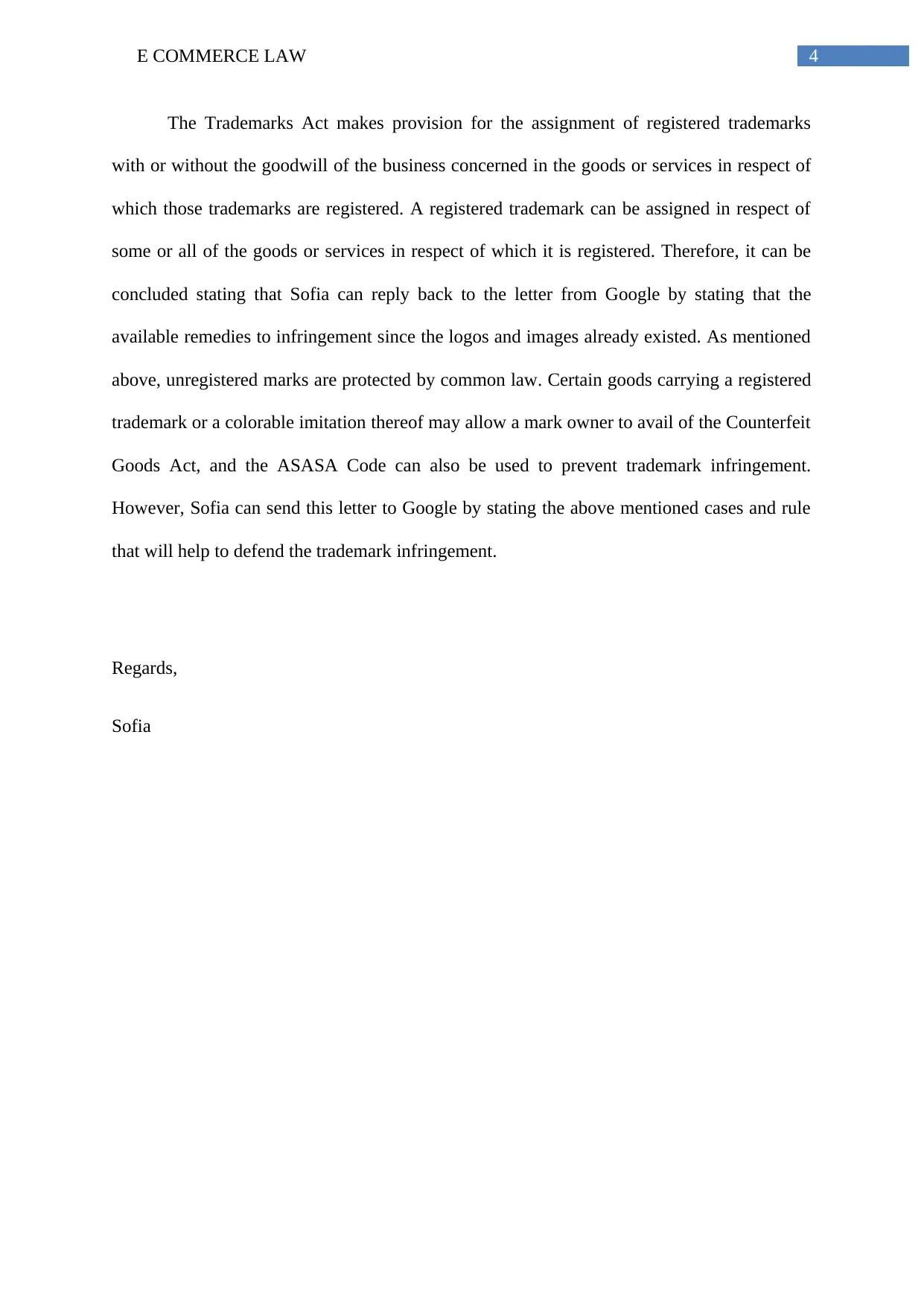
4E COMMERCE LAW
The Trademarks Act makes provision for the assignment of registered trademarks
with or without the goodwill of the business concerned in the goods or services in respect of
which those trademarks are registered. A registered trademark can be assigned in respect of
some or all of the goods or services in respect of which it is registered. Therefore, it can be
concluded stating that Sofia can reply back to the letter from Google by stating that the
available remedies to infringement since the logos and images already existed. As mentioned
above, unregistered marks are protected by common law. Certain goods carrying a registered
trademark or a colorable imitation thereof may allow a mark owner to avail of the Counterfeit
Goods Act, and the ASASA Code can also be used to prevent trademark infringement.
However, Sofia can send this letter to Google by stating the above mentioned cases and rule
that will help to defend the trademark infringement.
Regards,
Sofia
The Trademarks Act makes provision for the assignment of registered trademarks
with or without the goodwill of the business concerned in the goods or services in respect of
which those trademarks are registered. A registered trademark can be assigned in respect of
some or all of the goods or services in respect of which it is registered. Therefore, it can be
concluded stating that Sofia can reply back to the letter from Google by stating that the
available remedies to infringement since the logos and images already existed. As mentioned
above, unregistered marks are protected by common law. Certain goods carrying a registered
trademark or a colorable imitation thereof may allow a mark owner to avail of the Counterfeit
Goods Act, and the ASASA Code can also be used to prevent trademark infringement.
However, Sofia can send this letter to Google by stating the above mentioned cases and rule
that will help to defend the trademark infringement.
Regards,
Sofia
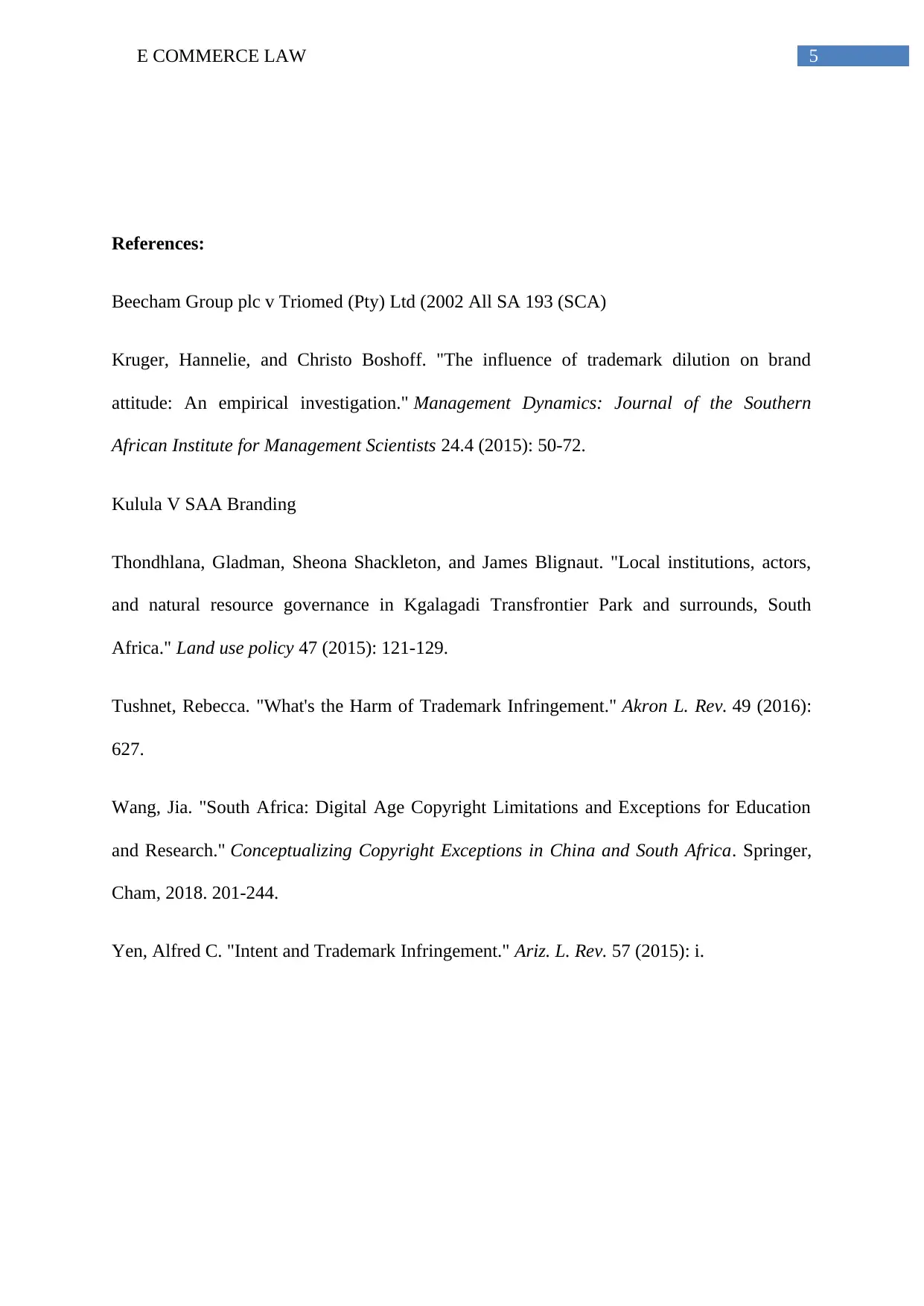
5E COMMERCE LAW
References:
Beecham Group plc v Triomed (Pty) Ltd (2002 All SA 193 (SCA)
Kruger, Hannelie, and Christo Boshoff. "The influence of trademark dilution on brand
attitude: An empirical investigation." Management Dynamics: Journal of the Southern
African Institute for Management Scientists 24.4 (2015): 50-72.
Kulula V SAA Branding
Thondhlana, Gladman, Sheona Shackleton, and James Blignaut. "Local institutions, actors,
and natural resource governance in Kgalagadi Transfrontier Park and surrounds, South
Africa." Land use policy 47 (2015): 121-129.
Tushnet, Rebecca. "What's the Harm of Trademark Infringement." Akron L. Rev. 49 (2016):
627.
Wang, Jia. "South Africa: Digital Age Copyright Limitations and Exceptions for Education
and Research." Conceptualizing Copyright Exceptions in China and South Africa. Springer,
Cham, 2018. 201-244.
Yen, Alfred C. "Intent and Trademark Infringement." Ariz. L. Rev. 57 (2015): i.
References:
Beecham Group plc v Triomed (Pty) Ltd (2002 All SA 193 (SCA)
Kruger, Hannelie, and Christo Boshoff. "The influence of trademark dilution on brand
attitude: An empirical investigation." Management Dynamics: Journal of the Southern
African Institute for Management Scientists 24.4 (2015): 50-72.
Kulula V SAA Branding
Thondhlana, Gladman, Sheona Shackleton, and James Blignaut. "Local institutions, actors,
and natural resource governance in Kgalagadi Transfrontier Park and surrounds, South
Africa." Land use policy 47 (2015): 121-129.
Tushnet, Rebecca. "What's the Harm of Trademark Infringement." Akron L. Rev. 49 (2016):
627.
Wang, Jia. "South Africa: Digital Age Copyright Limitations and Exceptions for Education
and Research." Conceptualizing Copyright Exceptions in China and South Africa. Springer,
Cham, 2018. 201-244.
Yen, Alfred C. "Intent and Trademark Infringement." Ariz. L. Rev. 57 (2015): i.
⊘ This is a preview!⊘
Do you want full access?
Subscribe today to unlock all pages.

Trusted by 1+ million students worldwide
1 out of 6
Related Documents
Your All-in-One AI-Powered Toolkit for Academic Success.
+13062052269
info@desklib.com
Available 24*7 on WhatsApp / Email
![[object Object]](/_next/static/media/star-bottom.7253800d.svg)
Unlock your academic potential
Copyright © 2020–2025 A2Z Services. All Rights Reserved. Developed and managed by ZUCOL.





